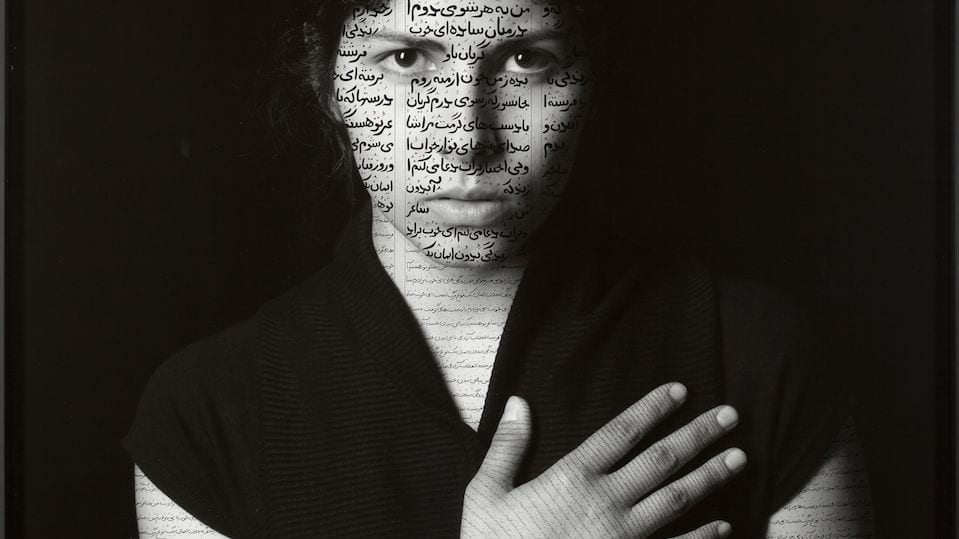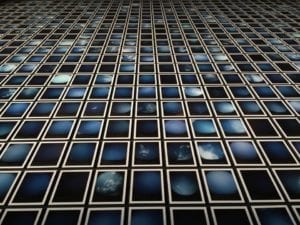An exhibition of women photographers from Iran and the Arab world offers insight into the complex identities of a region that is often misunderstood.
From the Arab Spring to the Gulf Wars and the rise of ISIS to the ongoing conflict in Gaza, Western media is saturated with images of the Arab world that characterise, manipulate and at times demonise the region. A new exhibition presents photographs by 12 of the leading women artists and photojournalists in the region, as an attempt to counter the politically motivated images we see every day with the antidote of art, allowing for more complex and nuanced perspectives. She Who Tells a Story is a powerful corrective to some of the assumptions and misconceptions that the media engine generates. With global political and media attention continuing to frame the Arab world in ways that dehumanise and undermine the complexities of its identity, an exhibition that celebrates the achievements of women photographers in the region could hardly be more timely and urgent. Furthermore, the recent lifting of sanctions on Iran promises a positive impact on creative freedom in the region, ushering in foreign investment and opening up the art market.
The exhibition’s title is drawn from an Arabic word for script, rawiya, which can be translated as “she who tells a story.” The indefinite article in the phrase is crucial. It reminds us that there is no definitive version of Arab experience, no single identity. Rather, She Who Tells a Story speaks to us of stories (plural), of multiple narrative possibilities. Ranging in style from fine art to photojournalism, they provide insight into a part of the world that has been historically misrepresented.
As its originating curator Kristen Gresh, who is the Estrellita and Yousuf Karsh Assistant Curator of Photographs at the Museum of Fine Arts, Boston, comments: “This exhibition is not only an invitation to discover new photographers but also an opportunity for us all to shift our perspectives away from the media and the constant stream of images that we see from the region and to put art and culture ahead of this.”
The depiction of women’s experiences in Iran and the Arab world is at the heart of the exhibition, but in ways that challenge clichéd depictions generated by the Western media. The vision of She Who Tells a Story is a fundamentally positive one, as Gresh explains: “As I was putting this exhibition together, one prominent Iranian artist warned me that focusing on a group of women photographers was ‘alarming’ because it would confirm the stereotype of Arab and Iranian women as being oppressed and powerless. “On the contrary, the works on view do just the opposite – they challenge that viewpoint, beckoning us to confront our own preconceptions and to explore new cultural landscapes.”
The work of Tehran-based artist Shadi Ghadirian collages objects from di erent time periods and associations to create dramatic and arresting tableaux. In her series Qajar (1998), Ghadirian uses props such as Pepsi cans, bicycles, ghetto blasters, sunglasses and banned or taboo publications in juxtaposition to a 19th century backdrop inspired by European, Orientalist perspectives on Iranian landscape.
One image portrays a young woman with the newspaper Hamshahri, a repeatedly banned publication that Ghadirian once worked for. In another, a mirror reflects foreign and banned books, an allusion to the censorship in Iran in the 1990s. The artworks, often very witty, serve to recast the Iranian woman as an empowered ironist and humourist.
Of all the misconstrued symbols of Arab womanhood in the West, perhaps the one with the most persistent and controversial traction is the veil. Yemeni artist Boushra Almutawakel deconstructs it, both as a symbol but also as a life choice for many women in countries in the region. Religious extremism, which is becoming increasingly pervasive in her native Yemen, calls for the public concealment of women’s, and even girls’, bodies. Without overtly denouncing the hijab or the full-body niqab, Almutawakel’s carefully constructed sequence of images Mother, Daughter, Doll (2010) show a mother and a daughter holding a doll, with their bodies seen in a variety of stages of concealment, from colourful clothing in the first image to total concealment in black in the last. It is tempting to read these as an erasure of the individual through a process of covering up, through the skewed perspective of Western culture in which women are constantly defined as individuals through the way they look. The photographs don’t pass judgment as much as they invite the viewer to engage with the choices they represent. While some women feel oppressed by the hijab, others feel empowered. The doll is crucial here, conveying a sense of motherhood and legacy, and exploring how representations of women will impact on future generations of young girls.
In a similar analysis of women’s agency in the Arab world, Shirin Neshat’s Women of Allah (1993-1997) grew out of a visit to her native Iran 15 years after the Iranian Revolution of 1979. These portraits, overlaid with Persian script (the words of contemporary Iranian women writers), highlight the crucial role that women played in the uprising. To Neshat, “Iranian women are quite powerful, unlike their clichéd image.” Incorporating elements of the veil, guns, text, and the gaze, these empowering compositions break down Orientalist tropes of female submission: one woman’s text-covered hand, when raised to her closed mouth, gives her a voice.
Working across both photography and video, Tehran-based Newsha Tavakolian interrogates restrictions placed on women in Iran, such as the tenet forbidding the recording of albums or performance of songs in public. Making portraits of professional Iranian singers performing in private, she creates a sense of them as artists that is denied them in the public sphere. Powerfully articulating their silencing (we can see them singing but cannot hear it), she simultaneously allows her subjects a voice, and a ords them the opportunity to perform. The series is entitled Listen (2010), an impassioned imperative and an instruction for the observer.
It is a sad and damning truth that many of the news images we see of the Arab world depict war. This reflects recent conflicts in the area, but also the ways in which media is saturated by a form of documentary photojournalism that by its nature obfuscates the complexities of situations. People look to newspapers and television for “the iconic shot” that seems to encapsulate a situation, but invariably such an image is only one facet of an incredibly complex and evolving situation. An uneasiness about documentary as a genre characterises many of the photographers in She Who Tells a Story, as National Museum of Women in the Arts Chief Curator Kathryn Wat explains: “Photographs tend to take on a documentary authority for most of us, but artists have always embraced the essential subjectivity of the camera’s eye. Among the pioneers of photography in the 19th century, women artists directed models and manipulated camera angles, lighting, colour and focus for expressive purposes. Like their artistic foremothers, the photographers in She Who Tells a Story use the camera to create compelling personal and cultural narratives that also destabilise the power of historical art and popular media to de ne their home.”
The work of Tehran-based Gohar Dashti, for example, recasts the fetishising of war photography in a theatrical and playful manner. In a series of uncanny images from Today’s Life and War (2008), a couple are depicted carrying out their everyday lives against a backdrop of a ctional war-torn landscape. In one image, they are seen on the ground at an impromptu table celebrating the Persian New Year, Nowruz, in another, they are seen as bride and groom in a beaten-up wreck of a wedding car. The photographs are punctured by a heightened sense of war, with familiar militaristic symbols such as a tank, barbed wire, a missile head and a wall of sandbags. On one level these photographs critique some Western preconceptions of the reality of war, but they also convey a powerful sense of metaphor for the experience of living with the reality of war. Dashti’s childhood was spent near the Iran-Iraq border and so the detritus and vocabulary of living in a war-effected region is something that her work powerfully articulates. As the artist explains: “This body of work represents war and its heritage, how it permeates all aspects of contemporary society … I create moments that capture the ongoing duality of life and war without precluding hope.” For an audience in the USA or in the UK, though, there is another sense in which these photographs are a reminder of how detached, sanitised and alien the realities of recent and ongoing con icts appear to us. Dashti’s photographs challenge us not to live our everyday lives ignorant of the realities of the wars that are perpetrated in our names.
Also taking as her subject a conflict that is an almost constant presence in the Western news media, the East Jerusalem-based artist Tanya Habjouqa presents portraits of women in Gaza that are a marked contrast to familiar images of the conflict. The photographs of Women of Gaza (2009) show women enjoying a picnic, taking part in an aerobics class and a group of schoolgirls on a boat trip. As Gresh states: “In the photograph of a boat ride, white hijabs frame the giddiness on the faces of schoolgirls in a motorboat from which a Palestinian flag flutters.” While, in a sense, Habjouqa is presenting the brighter side of life for Palestinians, there is another level on which her images also convey the restrictions that women and all residents of Gaza live with.
The boat ride is symbolic of restriction despite seeming to express a sense of freedom, because Palestinians can only go six nautical miles into the Mediterranean before reaching Israeli-restricted territories, so activities like this five-minute ride, while enjoyable, are also extremely limited in scope.
The works of the photographers in She Who Tells a Story reflect the people, landscapes and cultures of a part of the world that is all too often misrepresented internationally. Through a plurality and diversity of aesthetic perspectives, the exhibition critiques the view that a region can be defined in any singular territorial, religious, or ethnic way. While international media and political engines may cast the Arab world in a particular light, these photographs challenge perceived ideas about the represented nations. While not ignoring the legacy of war and ongoing conflicts, the show goes further than a traditional approach to documentary would demand, serving to dismantle the conventions of the genre while revealing the complexities of local identities.
Colin Herd
She Who Tells a Story. National Museum of Women in the Arts in Washington DC. 8 April – 31 July.





